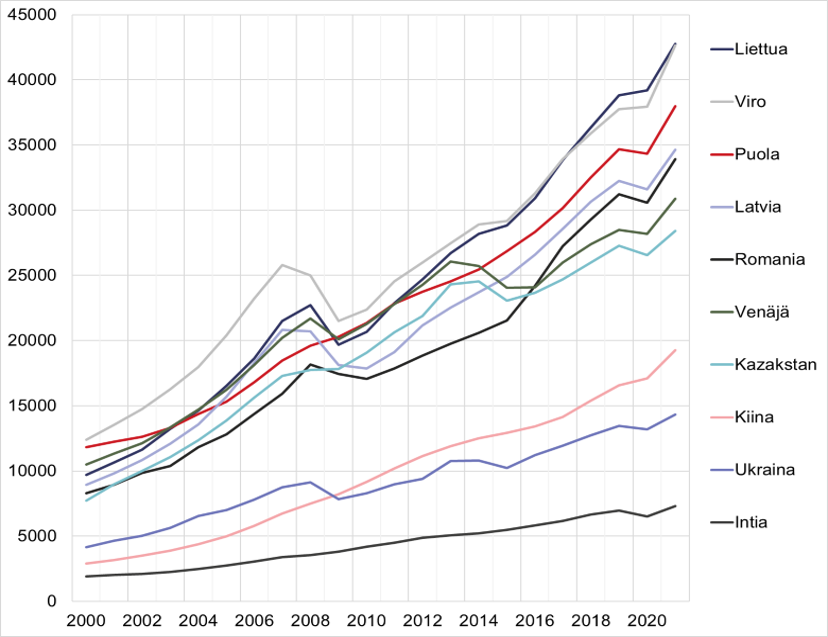BOFIT Weekly Review 05/2023
Ukraine’s economy shrank by about a third last year
According to the preliminary assessments, the country’s GDP contracted by roughly 30 % last year. Both private consumption and fixed investment have been deeply impacted since the Russia’s illegal invasion almost a year ago. Ukraine exports have also collapsed, due, among other things, to the disruption of Black Sea shipping. GDP fell by 37.2 % y-o-y in the second quarter of 2022 and 30.8 % in the third quarter.
The trends, however, were quite unevenly distributed from a geographic standpoint. As might be expected, the economy has suffered the most in the southern and eastern war zones that are either under temporary Russian occupation or disputed. Most of Ukraine’s export industries were based in the east or south of the country prior to the war.
In January, the macroeconomic survey firm Consensus Economics released a compilation of recent economic assessments suggesting that Ukrainian GDP contracted by 34.5 % last year and that the volume of fixed investment dropped by over 40 %. The January consensus forecast for GDP growth was 2.8 % this year and 9.1 % next year. The range of growth forecasts, however, remains quite wide as forecasting institutions use different assumptions about how and when the war ends, as well as the sort of peace accords reached.
In our latest BOFIT Policy Brief, we provide background information on the Ukrainian economy before the invasion and how the current war of aggression has impacted it. While pre-war Ukraine had a fairly low GDP per capita (lower middle income under the World Bank classification), its economy also exhibits features of advanced economies.
Ukraine’s GDP was about 200 billion dollars in 2021. The cornerstones of the economy were agriculture and heavy industry such as steelmaking. Ukraine’s most important agricultural exports were grains such as wheat and oilseed crops such as sunflower. Agricultural products accounted for over 40 % of the country’s exports. Ukraine’s Black Sea ports are crucial to its economic and geopolitical security; before the war nearly 70 % of the country’s exports flowed through them, including over 90 % of agricultural exports. Due to Ukraine’s trade agreement with the EU and Russia’s actions, Ukraine’s foreign trade was already pivoting away from Russia before February 2022.

Source: State Statistics Service of Ukraine.
Ukraine is characterised by social development features typical of both lower-middle-income countries and high-income countries. For example, in terms of access to financial services, Ukraine more closely resembles a high-income country than a lower-middle-income country. On the other hand, Ukraine must overcome large challenges such as poor infrastructure and the paucity of services in rural areas. In addition, corruption and the informal economy are big problems. The majority of Ukrainians responding to a 2020 corruption survey said that they had experienced corruption in such areas as public healthcare services. About a fifth of the Ukrainian workforce was employed in the informal economy in 2020.
War has been hard on Ukraine’s public sector due to the decline in tax revenues to the state and increased government spending. As a result, the National Bank of Ukraine, the country’s central bank, has had to finance the government. Ukraine has also seen an increase in support from the international community, albeit insufficient to cover the costs of Ukraine’s war effort. In the more optimistic scenarios of Ukraine’s future, reconstruction efforts are seen as getting underway already this year with Ukraine becoming an EU member as early as 2032. According to Ukraine’s own estimates, the total costs of military assistance and reconstruction are likely to exceed 750 billion dollars by 2032. The estimates assume that two-thirds of funding would come from Ukraine’s foreign partners. Ukraine would like to see its EU membership as soon as possible as it would help with reconstruction and improve access to foreign investment.
While Ukraine’s GDP per capita (in PPP-adjusted dollars) is lower than its neighbours, it shares features with advanced economies

Source: IMF.